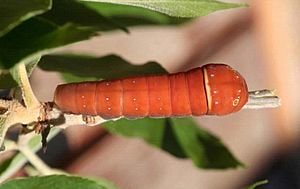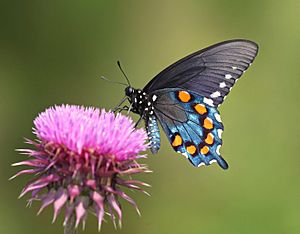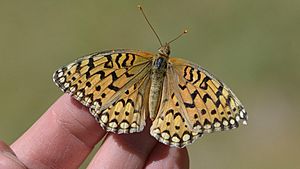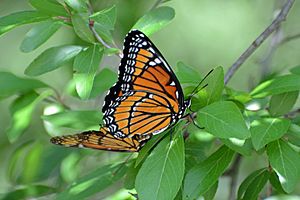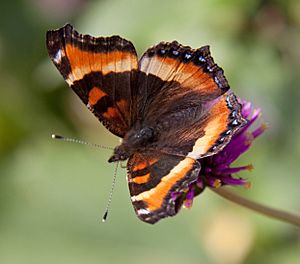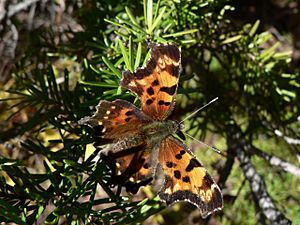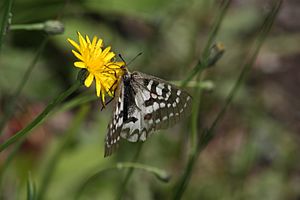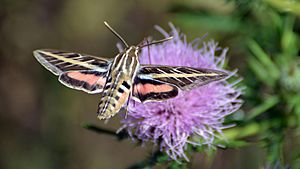List of Lepidoptera of Utah facts for kids
Did you know that Utah is home to many amazing butterflies and moths? These beautiful insects are part of a group called Lepidoptera. They add so much color and life to our state's landscapes. From tiny moths to large, colorful butterflies, Utah's diverse environments support a wide variety of these winged creatures.
Contents
Discovering Utah's Butterflies and Moths
Butterflies and moths are fascinating insects. They belong to an order called Lepidoptera. This name comes from Greek words meaning "scaly wings." If you look closely, their wings are covered in tiny, overlapping scales. These scales create all the amazing colors and patterns you see.
What Makes Butterflies and Moths Different?
Even though they are related, butterflies and moths have some key differences.
- Antennae: Butterflies usually have thin antennae with small clubs at the end. Moths often have feathery or thread-like antennae without clubs.
- Resting Position: Butterflies typically rest with their wings held upright over their backs. Moths usually rest with their wings flat or tent-like over their bodies.
- Activity Time: Most butterflies are active during the day (diurnal). Many moths are active at night (nocturnal), but some fly during the day too!
The Amazing Life Cycle of Lepidoptera
Butterflies and moths go through a complete metamorphosis. This means they change completely during their lives. Their life cycle has four main stages:
- Egg: It all starts when a female lays tiny eggs, often on a specific plant.
- Larva (Caterpillar): The egg hatches into a larva, which we call a caterpillar. Caterpillars spend their time eating and growing. They shed their skin several times as they get bigger.
- Pupa: Once a caterpillar is fully grown, it forms a pupa. For butterflies, this is called a chrysalis. For moths, it's usually a cocoon. Inside the pupa, the caterpillar transforms.
- Adult: Finally, the adult butterfly or moth emerges from the pupa. The adult's main job is to find a mate and lay eggs, starting the cycle again.
Common Butterflies You Might See in Utah
Utah's varied habitats, from deserts to mountains, are home to many beautiful butterfly species. Here are a few you might spot:
Swallowtail Butterflies
Swallowtails are large, colorful butterflies. They often have "tails" on their hindwings, which look a bit like a bird's tail.
- The Two-tailed swallowtail (Papilio multicaudata) is one of the largest butterflies in Utah. It's bright yellow with black stripes and two tails on each hindwing.
- The Anise swallowtail (Papilio zelicaon) is similar but usually has one tail per hindwing.
- The Pipevine swallowtail (Battus philenor) is a beautiful dark butterfly with iridescent blue-green on its hindwings and orange spots.
Fritillary Butterflies
Fritillaries are medium-sized butterflies. They often have orange and black patterns on their wings. Their undersides can have shiny silver spots.
- The Callippe fritillary (Speyeria callippe) is a common type found in Utah.
- The Great spangled fritillary (Speyeria cybele) is another large and striking species.
Brush-footed Butterflies
This is a very large family of butterflies. Many have dull colors on the underside of their wings to help them blend in.
- The Monarch butterfly (Danaus plexippus) is famous for its long migrations. It's bright orange with black veins.
- The Viceroy butterfly (Limenitis archippus) looks very much like the Monarch. This helps it avoid predators!
- The Painted lady butterfly (Vanessa cardui) is one of the most widespread butterflies in the world. It has orange, black, and white patterns.
- The Milbert's tortoiseshell (Aglais milberti) has a unique orange band on its dark wings.
- The Green comma (Polygonia faunus) has jagged wing edges and a small white mark on its hindwing that looks like a comma.
- The Common buckeye (Junonia coenia) has large, colorful eyespots on its wings.
Parnassian Butterflies
These butterflies are often found in mountain areas. They are usually white or pale yellow with black markings and sometimes red spots.
- The Clodius parnassian (Parnassius clodius) is a good example of this group.
Moths: Utah's Nighttime Wonders
While butterflies get a lot of attention, moths are just as important and diverse. Many moths are active at night, but some, like the sphinx moths, can be seen during the day.
- The White-lined sphinx moth (Hyles lineata) is a common moth in Utah. It's a strong flyer and can hover like a hummingbird. It has striking pink and white stripes on its wings.
- The Five-spotted hawkmoth (Manduca quinquemaculata) is another large moth. Its caterpillar is known as the tomato hornworm, a common garden pest.
- Some moths, like the Army cutworm (Euxoa auxiliaris), are known as agricultural pests because their caterpillars can damage crops.
Why Are Lepidoptera Important?
Butterflies and moths play a vital role in our ecosystems.
- Pollinators: As they visit flowers to drink nectar, they carry pollen from one plant to another. This helps plants reproduce and grow fruits and seeds. Many plants, including those we eat, rely on pollinators.
- Food Source: Caterpillars and adult moths and butterflies are an important food source for many animals. Birds, bats, and other insects all rely on them for food.
- Indicators of Health: The presence of many different butterfly and moth species can tell us if an environment is healthy. If their numbers decline, it can be a sign that something is wrong in the ecosystem.
Protecting Utah's Butterflies and Moths
Many butterfly and moth populations are facing challenges. Habitat loss, pesticide use, and climate change can all harm them. Here's how you can help protect these amazing insects:
- Plant a Garden: Plant native flowers that provide nectar for adults and host plants for caterpillars.
- Reduce Pesticides: Try to avoid using harmful chemicals in your garden.
- Learn More: The more you learn about these creatures, the more you can appreciate and help protect them!


